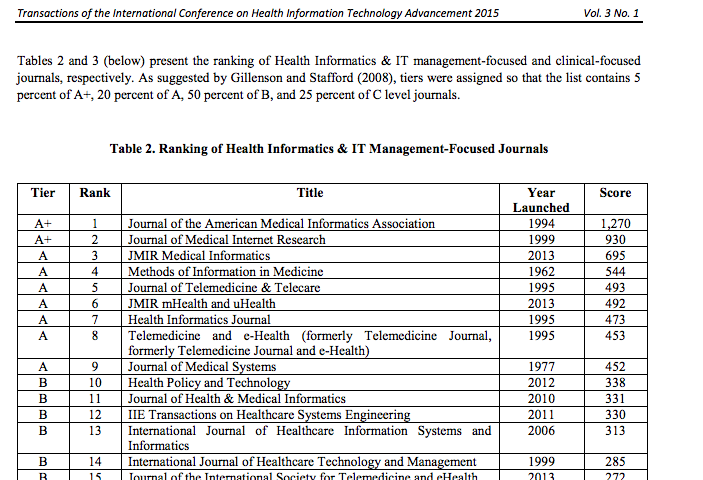Update: This is an archived post. The actual impact Factors have been released in June 2017 and JMIR mHealth exceeded our expectations with a stunning impact factor of 4.636
(Toronto, 25 Jan 2016) As recently announced, Thomson Reuters, producer of the Journal Citation Reports and Web of Science and other database products, is creating a new edition of Web of Science (Emerging Sources Citation Index, ESCI), and we are proud that JMIR mHealth and uHealth is one of the journals selected for inclusion (Update added Jul 13, 2016: Thomson Reuters informs us that JMIR mHealth and uHealth has now also been accepted for Science Citation Index Expanded, meaning that it will have an official IF in 2017). We are often asked by authors "What is the impact factor of JMIR mHealth and uHealth [or another JMIR sister journal]", even if this journal is still relatively new.
The 2015 impact factor of a journal can be calculated as follows (Wikipedia):
- 2015 impact factor = A/B
where:
- A = the number of times that all items published in that journal in 2013 and 2014 were cited by indexed publications during 2015.
- B = the total number of "citable items" published by that journal in 2013 and 2014.
The Journal Impact Factor can therefore only be calculated in year 4 of the existence of a journal (only in 2016 we know how many citations the articles from 2013-2014 accumulated in 2015), thus an impact factor is undefined for the first 4 years, and authors can only look at the number of citations their specific article produces to gather "impact" of their work! And in practice, it takes Thomson Reuters much longer than 4 years to officially list a journal in its Journal Citation Reports (JCR). In the meantime, some publishers calculate "unofficial" impact factors, which can be done for a 2015 impact factor by dividing the number of published articles in the previous two years (B) by the number of results when searching Web of Science for citing articles published in 2015 (A).
JMIR mHealth and uHealth is now finally "old" enough (>4 years) that we can comment on the impact factor.
The projected impact factor for JMIR mHealth and uHealth (2015) is 2.03, calculated from 167 citations (citing articles from 2015) / 82 (published articles 2013-2014).
To be very clear, this is not an official impact factor published in JCR by Thomson Reuters, although it mirrors their methodology (as first proposed by Eugene Garfield). This number represents the average number of citations for our articles published in 2013-2014. This is a conservative measure which is still increasing, because the Web of Science search was conducted early 2016, while the number of citations in 2015 may still increase, as the index catches up on 2015 publications.
This impressive number confirms JMIR mHealth and uHealth as a journal that is - while perhaps not a top cited journal such as JMIR - an above-average cited journal, which is cited more often than half of the journals listed in the JCR Medical Informatics category (the median impact factor for the 24 journals in that category was 1.828 in 2014, meaning that JMIR mHealth and uHealth would be in the upper half of the officially ranked JCR journals). More precisely, it would be ranked #11 in that discipline, ahead of journals such as BMC Medical Informatics (#12) or Applied Clinical Informatics (#15). This is a remarkable achievement for a new journal, and it mirrors the success of other JMIR sister journals such as JMIR Serious Games (projected IF: 1.8) or i-JMR (projected IF: 1.6).
In the meantime, while we await the official Thomson Reuters report with JMIR mHealth and uHealth included, we hope that Tenure & Promotion Commitee's will follow the recommendations of the DORA statement, which recommends to take into account other metrics (in particular article-level metrics, but also "proxy calculations" such as the one conducted above), while we are awaiting an "official" impact factor. We invite authors who are faced with questions from their T&P Committee to include this calculation.
Beyond the Impact Factor: Expert Ratings
For authors faced with questions about the ranking of JMIR journals which do not have an impact factor yet, the following may also provide evidence that they are top journals: According to a survey among 398 health informatics experts who are asked to rank the top health informatics journals by Dohan et al (The Expert Survey-Based Global Ranking of Management- and Clinical-Centered Health Informatics and IT Journals, Transactions of the International Conference on Health Information Technology Advancement. Paper 45. http://scholarworks.wmich.edu/ichita_transactions/45), JMIR and it's (then) 2 sister journals JMIR Medical Informatics and JMIR mHealth were all ranked in the top tier, namely in the A+ (top 5%) and A (top 20%) tiers.
